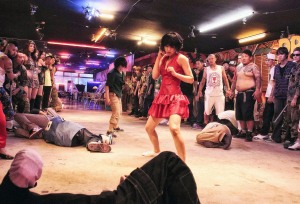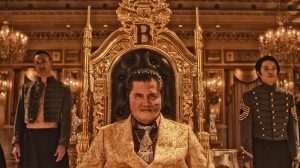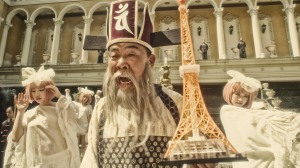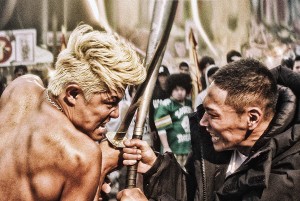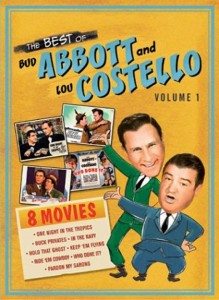A LOVE-NOTE TO PEGGY LEE, ONE OF THE GREATEST SINGER/SONGWRITERS OF THE RECORDING ERA (by STEVE WAGNER)

A tip of the top hat and genuflection to Miss Peggy Lee, today celebrating the centennial of her birth. Peggy has long been one of my very favorite singers, from the day a friend turned me onto her album SUGAR ‘N’ SPICE in 1984. In the years since, I have delved deeply into her catalog, which is truly a gift that keeps on giving. Peggy was a towering figure in 20th century popular music. A singer for the ages, she was also one of the most accomplished lyricists in music history, and mostly at a time when very few women were songwriters, much less singer/songwriters. She was an innovator throughout her six-decade career, and, like most great artists, was restless, experimental, uncompromising, and a perfectionist. It is said she ran her sessions with no patience for lip, or amateurs. One simply did not question Miss Lee’s taste, or decisions, if one wanted to stay on her record.

As someone who really values great vocals, I find Peggy’s oeuvre to be an indispensable primer on what makes a great singer a great singer. Frankly, most current singers leave me cold – I’m distracted and irritated by the faux emotion, self-indulgent delivery, calculated moans, endless vocal gymnastics at the expense of melody, and puzzling lack of awareness of what THE SONG is asking for. Peggy never exhibited such rookie behavior; she accomplished what every song called for with the exact opposite approach – rich tone, perfect pitch, intuitive timing, impeccable phrasing, and thoughtful understatement. She was a master of the “less-is-more” style, which I find much more moving than the egoic wailings we are frequently inundated with now. Peggy’s voice flourished across so many styles and genres – pop, jazz, cabaret, torch, blues, and comedy/novelty – while always remaining utterly singular and instantly recognizable.

It would be impossible to summarize her long career here, suffice to say it is very telling that it closely mirrored that of Frank Sinatra’s throughout the decades. They both had their introductions as singers fronting the top big bands of the swing era – Frank with Tommy Dorsey and Peg with Benny Goodman – with both quickly becoming breakout stars on their own. Both dominated the charts as solo artists in the 1940s. Peg scored over twenty Top 40 songs in that decade, with her “Mañana (Is Soon Enough for Me)” the number one song of 1948, and Capitol Records’ top-selling single for sixteen years, until the Beatles’ “I Want to Hold Your Hand” in 1964. Both branched into acting in the mid-50s with Oscar-nominated performances (Frank for FROM HERE TO ETERNITY, Peg for PETE KELLY’S BLUES), and both also pioneered the concept album during this period (Frank with IN THE WEE SMALL HOURS, and Peg with BLACK COFFEE). Both managed to survive the explosion of rock and roll, maintaining a consistent chart presence throughout the ‘60s – indeed, they were really the only two singers from the big band years to remain commercially viable through that decade, even recording songs that are now considered amongst their best work. And both were ultimately defined by seminal songs late in their games – Frank for the testimonial “My Way” and Peg for the existential “Is That All There Is?” – which finally garnered her a Grammy for Best Vocal Performance in 1969, at the height of the classic rock era.

As a songwriter, Peggy is up there with the greats. She collaborated with many giants of the form – Harold Arlen, Mel Tormé, Victor Young, Cy Coleman, Sonny Burke, and Duke Ellington. Her songs graced numerous films, among others THE JAZZ SINGER (1952); TOM THUMB (1958); ANATOMY OF A MURDER (1959); THE RUSSIANS ARE COMING, THE RUSSIANS ARE COMING (1966); WALK, DON’T RUN (1966); THE HEART IS A LONELY HUNTER (1968); and, of course, Disney’s LADY AND THE TRAMP (1955), for which Peg composed the songs, and sang and voiced the parts of the female characters, not to mention two very devious Siamese cats. So many of her songs are timeless standards: “It’s a Good Day,” “Golden Earrings,” “I Don’t Know Enough About You,” “Johnny Guitar,” “Don’t Smoke in Bed,” “Mañana,” “He’s a Tramp,” and “I Love Being Here with You,” just to name a few. And while her career-defining hit “Fever” was originally penned by Eddie Cooley and John Davenport, Peggy added two original verses (“Romeo loved Juliet… ” and “Captain Smith and Pocahontas… ”) for her definitive version, and also came up with the idea to transpose the key up a half-step for each verse, which perfectly communicated the “rising temperature” motif. When the dust settled, her songs had been recorded by the cream of 20th century crooners and canaries: Bing Crosby, Ella Fitzgerald, Judy Garland, Nat “King” Cole, Tony Bennett, Sarah Vaughan, June Christy, Mose Allison, Della Reese, Jack Jones, Perry Como, Dean Martin, Sammy Davis Junior, Annie Ross, Elvis Presley, Nina Simone, Mark Murphy, Dionne Warwick, Michael Feinstein, kd lang, and Madonna.

If you’ll indulge me a few anecdotes I feel speak to Peg’s unique impact: She gave Quincy Jones a commercial biz leg-up in the early ‘60s, hiring the jazz wunderkind to arrange and produce for her. She gave her longtime lover Robert Preston singing lessons in preparation for his role as Harold Hill in THE MUSIC MAN. She was a favorite of Jerry Leiber and Mike Stoller, charting one of their gems, “I’m a Woman” in 1962, which stands with Leslie Gore’s “You Don’t Own Me” as a proto-feminist anthem. Jerry and Mike claim that a few years later she threatened to have their legs broken if they didn’t give her “Is That All There Is?” (which also became the first hit to feature Randy Newman, who was arranger). She was the inspiration for “Miss Piggy” on THE MUPPET SHOW and essentially the genesis of the Jessica Rabbit character in WHO FRAMED ROGER RABBIT, her immortal “Why Don’t You Do Right” the song Jessica breathlessly sings to a mouth-agape Bob Hoskins. In addition to cutting nearly every substantial tune from the Great American Songbook, she recorded songs by rock/pop innovators Burt Bacharach, Carole King, Jimmy Webb, George Harrison, John Sebastian, Buffy Saint Marie, and Ray Davies. Paul McCartney, a huge fan, specially wrote the song “Let’s Love” for her in 1973, one of her last singles. kd lang, one of today’s most acclaimed singers, considers Peggy to be a primary influence. Peggy’s nightclub performances are the stuff of legend – extended residencies at Basin Street East in New York in the early ‘60s attracted a veritable who’s who of show business glitterati nightly. The Beatles were said to have wanted to attend when they first came over to do the Sullivan Show, but knew that Beatlemania would overwhelm the club and respected her too much to disturb. And finally, Peggy sang at Louis Armstrong’s funeral. Mic drop.

If you have the time (and who doesn’t, these days?) I implore you to explore this incredible artist. Recommended albums: BLACK COFFEE (1956); DREAM STREET (1957); BEAUTY AND THE BEAT (1959); BASIN STREET EAST (1961); and MINK JAZZ (1963). Below, please find several songs and videos that I hope bring Peggy’s brilliance into deeper perspective.
Enjoy, and HAPPY 100TH BIRTHDAY, PEGGY!
First, here is an amazing film of Peggy at Basin Street, performing “See See Rider” with a presence that is, in a word, riveting. Tell me she doesn’t have the most expressive face this side of Elvis.
Peggy’s celebrated score for Disney’s LADY AND THE TRAMP in 1955 remains among her best known and most beloved work. It’s easy to hear why. Both the lyrics and vocal delivery are laced with lighthearted humor and cleverness. The two most famous songs from the movie – “He’s a Tramp” and “The Siamese Cat Song” – easily rank with the very best in the entire Disney animated film canon.
““He’s a Tramp”
““The Siamese Cat Song”
A wonderful example of Peggy’s singular approach to the blues, “I’m Looking Out the Window” is a simple sad chord progression in no hurry whatsoever to reach its destination, and only becomes a blues number because of the way Peggy interprets it. She takes what would be a straightforward melody and bends it into a poignant lament on waiting for a love that never arrives. Note that her take on this tune uses the same structural trick as her version of “Fever,” bouncing the key up a step with every other verse. This would normally produce a sense of hopefulness, or at least growing excitement. Peggy tempers this expectation by phrasing the lines more and more languidly as the song progresses.
One of the great, and still mostly overlooked, tunes from the standards era, this longing ballad (written by THE WIZARD OF OZ composer Harold Arlen in 1941) was recorded by nearly everyone, but never became a sizable hit for anyone. Among those who cut “When the Sun Comes Out” were the likes of Ella Fitzgerald, June Christy, Tony Bennett, Mel Tormé, and Nancy Wilson. Notably, it was one of Barbra Streisand’s earliest recordings, the B-Side of her first single, 1962’s “Happy Days Are Here Again” (later re-recorded for THE SECOND BARBRA STREISAND ALBUM in 1963). But to my ears, Peggy’s version is the best of them all. She never strays from the melancholy feeling the lyrics demand, never falls prey to affecting a “big finish” beyond allowing her voice to become more emotional as the narrative builds. The arrangement rightly follows suit. This is a song that is meant to evoke, not entertain, and Peggy’s version does just that, perfectly.
A great example of how to subtly turn a jazz number into relatable pop, “I’m Gonna Go Fishin” is a co-composition by Peggy and Duke Ellington featured in the classic Jimmy Stewart courtroom drama ANATOMY OF A MURDER in 1959. Peggy’s lyric masterfully matches the jazzy intervals while winking at the listener throughout. She’s out to “catch me a trout,” alright, and her vocal supplies all the needed innuendo even if one can’t discern the barely concealed true intent in the lyric.
Paul McCartney loved Peggy, and composed this soft nugget for her in 1973, where it became one of her last singles and the title of the album on which it was featured. “Let’s Love” is unmistakably a McCartney melody, but Paul clearly strove to create a song that would allow for and accent Peggy’s personal style. This is one that every Beatle fan should know and serves as both love letter and testament to Peggy’s bedrock influence on the pop artists and songwriters—at least the respectful ones—who followed in her footsteps.
Peggy should absolutely be inducted into the Rock and Roll Hall of Fame, and not just as an influencer, but as a singer who deftly made the transition from easy listening into the more hard-edged styles of the rock era. This recording alone should be enough to deem her worthy. Written by the great songwriting team of Leiber and Stoller, “I’m a Woman” ranks with their best, and Peggy simply hits it out of the park.
Peggy’s two most famous songs show the wide range of her talent as a vocalist, bringing precisely the right emotion to the needs of each. “Fever” is the quintessential torch song, and Peggy sings it with a brusque beguile that is always on the verge of boiling over while maintaining a shrewd detachment. This wise woman schools us on sex as she works us into a lather. Conversely, “Is That All There Is?” is the ultimate world-weary take on life and loss and the eternal question of “to be, or not to be.” I remember being stunned, at the age of nine, by the directness of this song, as I realized what Peggy was really singing about. This is one of the most unique songs to dominate the 20th century pop charts, and Peggy sings it like someone who has lived it. Because she had.
“Fever”
“Is That All There Is?”


